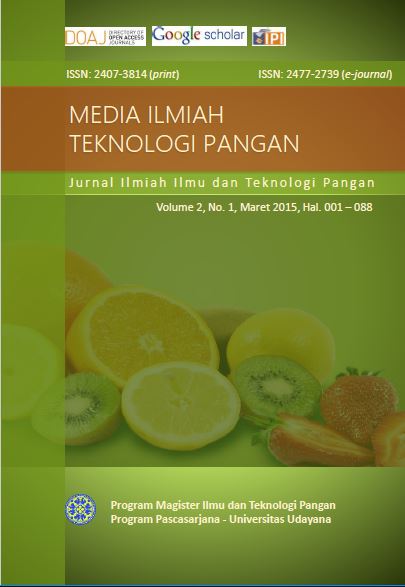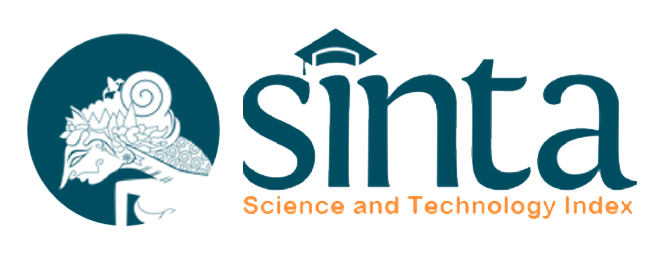Formulation of Skim milk and Soy milk on Producing Soyghurt
Abstract
Soyghurt (yoghurt made from soymilk) is better than yoghurt made from cow’s milk because of their lower in cholesterol, saturated fatty acid and lactose content. Objective of this research was to find out the effect of skim milk and soymilk formulation on the chemical and organoleptik characteristic of soyghurt produced. This research was designed with a completely randomized design (CRD) with 4 treatments i.e. formulations of skim milk and soy milk 100%:0%, 75%:25%, 50%:50%, and 25%:75%. The results showed formulation of skim milk and soy milk significantly affected the pH, flavor, aroma, and texture, of soyghurt produced, but did not significantly affected the protein content and color. The increase of the level of soy milk tends to lower the pH of soyghurt produced. Based on the sensory evaluation and chemical analysis the best formulation of skim milk and soy milk in producing soyghurt, was 25% of skim milk and 75% of soymilk. The formulation provided soyghurt with protein content of 4.85%, pH of 4.1, total acid of 0.75%; as well as color preferred, aroma rather preferred, and texture preferred by panelist..
Downloads
References
AOAC. 1995. Official Methods of Analysis. 14th Edn. Association of official analytical chemists, Washington, DC
Delia C. and E. Herbert. 1986. Food facts, A study of Food Nutrition,1st edition. Macmillan Publishers Company, London.
Dixit, A.K., J. I. X. Antony, N.K. Sharma and R. K. Tiwari. 2011. Soybean constituents and their functional benefits. In V.K. Tiwari and B.B.Mishra (Ed.). Opportunity, Challenge and Scope of NaturalResearch Singnpost, Kerala
Kanda, H., H.L. Wang, C.W. Hesseltine and K. Warner, 1976. Yoghurt production by Lactobacillus fermentation of soybean milk. Process Biochemistry. 1:23-25.
Pham, T.T and N.P. Shah. 2009. Effects of skim milk powder supplementation to soy yogurts on biotransformation of isoflavone glycosides to biologically active forms during storage. International Journal of Biological and Life Sciences 5(1): 14 – 20
Pithong, R., R. Macrae and J. Rothwell, 1980. The development of Soya-based yoghurt II Sensory evaluation and analysis of volatiles. Journal of Food Technology. 15:653-655.
Scalabrini, P., M.Rossi, P. Spettoli and D. Matteuzzi. 1998. Charaterization of Bifidobacterium strains for use in soymilk fermentation. International
Journal of Food Microbiology 39: 213 – 219
Shin, H.S., J.H. Lee, J.J. Pestka, and Z. Ustunol. 2000. Growth and viability of commercial Bifidobacterium spp. in skim milk containing oligosaccharides and inulin. Journal of Food Science 65: 885 – 887
Sumarna. 2008. Changes of raffinose and stachyose in soy milk fermentation by lactic acid bacteria from local fermented foods of Indonesian. Malaysian Journal of Microbiology, 4(2): 26 - 34
Wirakusumah, E.S. 2007 . Mencegah Osteoporosis. Penebar Plus, Jakarta
Yamaguchi, M. 2002. Isoflavone and bone metabolism: its cellular mechanism and preventive role in bone loss. J. Health Sci. 48(3): 209 - 222.








